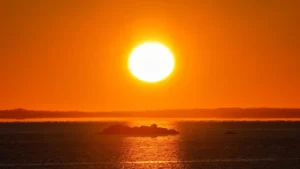
OAP journalists witnessed the devastation, with nearly every building destroyed on Front Street, the heart of the Maui community and the economic center of the island of the same name.
The current fires are the deadliest and most destructive disaster in Hawaii since the 1960 tsunami, which killed 61 people.
A deadlier tsunami in 1946, which caused more than 150 deaths, led to the creation of an island-wide emergency system, which included sirens, which were tested every month.
But many survivors now say they didn’t hear any sirens or receive any alerts in time to prepare. They only realized they were in danger when they saw the flames or heard explosions nearby.
Hawaii emergency services records have no indication that the sirens were triggered to warn people. Instead, alerts were sent to mobile phones, televisions and radio stations. But widespread power and network outages limited the reach of the warnings.
Governor Josh Green has already warned that the death toll will continue to rise as search and rescue operations continue.
“Recovery is going to be extraordinarily complicated, but we want people to go back to their homes and do what they can to get them safely evaluated, because it’s so dangerous,” Green told Hawaii News Now.
Fueled by a dry summer and strong hurricane winds, at least three fires broke out this week on Maui, spreading through the dry vegetation that blanketed the island.
The most serious one entered Lahaina on Tuesday and left mounds of ash between the blue ocean and lush green hillsides.
In the landscape, what you see are the skeletal remains of buildings, burned palm trees, burned boats in the port, all under an unpleasant smell of burning.
This fire was the deadliest in the US since the 2018 Camp Fire, in the State of California, which killed 85 people and reduced the city of Paradise to ashes.
Dogs capable of smelling dead bodies have been brought to the island to help locate bodies, Maui City Council President Richard Bissen Jr. said.
Lahaina’s fire hazards were well known. The Maui County mitigation plan, updated in 2020, identified Lahaina and other communities in western Maui as having frequent fires and a large number of buildings at risk of fire damage.
The document also pointed out that this part of the island had the second highest rate of people without a vehicle and the highest rate of non-English speakers.
“This can limit the population’s ability to receive, understand and act in a timely manner in problem scenarios”, the plan warned.
On the other hand, firefighting efforts have been hampered by the reduced number of firefighters, said the president of his association in Hawaii, Bobby Lee. The maximum number of firefighters that are available at any time in Maui County is 65, responsible for firefighting on three islands, namely Maui, Molokai and Lanai, he stressed.
Furthermore, these firefighters have around 13 firefighting vehicles and two trucks with ladders, but not a single all-terrain vehicle. This means that they cannot attack forest fires before the flames reach roads or populated areas.
Also Read: Fires. Images from the “greatest natural disaster in Hawaiian history”
Always be the first to know.
Seventh consecutive year Consumer Choice for Online Press.
Download our free App.

Source: https://www.noticiasaominuto.com/mundo/2379422/residentes-na-cidade-destruida-pelo-fogo-no-havai-podem-agora-regressar



